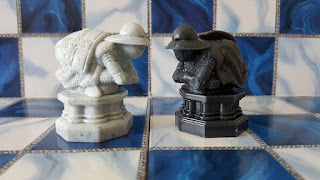Sunday, January 15, 2017
Foiled Again
Have you ever noticed a pair of characters so alike in so many ways and so opposite in others? I'm quite sure you have. Any English major can tell you these pairs of characters are called foils of each other. Foils are incredibly useful in characterization. Look at Tom Riddle [a young Voldemort] vs. Harry Potter. They have so much in common. They're both orphans with black hair, incredible gifts, and a tendency to work outside the rules. They both attract the particular attention of Dumbledore. The list goes on and on. What makes them different? Their choices. Tom chooses to embrace the darkness while Harry rejects it on every side. These similarities and differences give Rowling the chance to enhance the reader's understanding of both characters. We see the path Harry could have taken had he embraced the darkness that lurks inside and watch as he, instead, chooses a different path.
If your tastes are more toward the literary fiction, you'll see even more foils than in genre fiction. Look, for instance at "Pride and Prejudice." Darcy and Lizzy are clear foils of each other. They at first can't stand each other because of their character differences. Yet at the same time, they both personify the traits of pride of their position and prejudice of the other class. They only want to speak if others will be impressed with their words. They both have rebellious streaks against overbearing mother figures. In some ways, they could not be more different, yet at the same time, they couldn't be more similar. Their differences and similarities highlight the same in the other.
Let's look at fairy tales for a moment. You may think that Snow White couldn't be more different from her evil step mother because the princess is pure, innocent, and kind, while the step-mother is vain and murderous. This just means you haven't looked past Disney's version. If you look carefully at the Grimms brothers' rendition of the story, Snow White's own vanity mirrors her step-mother's. Her vain step-mother is only able to entrap her because she's drawn to ribbons, laces, corsets, combs, and the like. The queen wants to kill Snow White, yet the story ends only after Snow White and her prince have the evil queen dance herself to death. These two female characters are so different in so many ways, yet they are so similar at their core.
No matter what your genre or themes, the power, meaning, and literary strength of your story can be enhanced through careful attention to foils. If your villain is all dark and hero is all light, both are boring and fall flat. However, if your hero is noble and heroic but for his attraction to the dark, and your villain is angry and vindictive but drawn to the light in spite of himself, they both start to get more interesting. Just look at Kylo Ren and Rey from Star Wars Episode 7. He's angry and dark but drawn by the light inside. She joined the light but yet is often tempted by rebellious, angry, or selfish impulses. Neither is perfectly one or the other, and their similarities and differences weave them together and highlight the reader's understanding of both. Look through natural pairs of characters in your writings. How can you enhance your own characterization through the use of foils?
Subscribe to:
Post Comments (Atom)





No comments:
Post a Comment